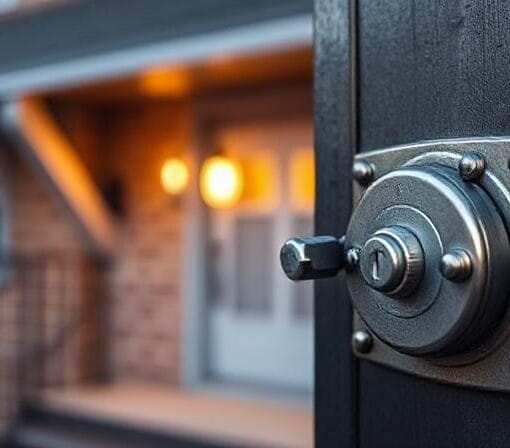Please Note: This post may contain affiliate links. If you click one of them, we may receive a commission at no extra cost to you. As an Amazon Associate, I earn from qualifying purchases.
Top Takeaways and Key Concepts
- Secure your base early by building simple barriers using logs, rocks, or branches.
- Use natural alarms like sticks, stones, or noise traps to detect movement near camp.
- Stay alert to threats by observing wildlife behavior, weather changes, and unfamiliar people.
- Reinforce camp security with physical defenses and smart positioning using terrain advantages.
- Build trusted connections with nearby people to increase safety, support, and shared defense.
Summary of This Article
This article explains how to protect a survival base in the wilderness by staying alert and taking strategic security measures. It emphasizes building physical barriers, setting up noise-based warning systems, and choosing defensible locations using natural terrain. The article also stresses situational awareness—watching for wildlife signs, changing weather, and potential human threats—and highlights the importance of building community connections for shared safety and teamwork. With the right mindset and simple tools, anyone can secure their outdoor shelter and enjoy greater peace of mind in nature.
Short Video Version of this Article
Picture this: you’ve made your own comfortable place in the woods. You’ve built a cozy little home, gathered some supplies, and even discovered food and water. It feels good, doesn’t it? But wait a minute!
How about making sure your home is safe? The outside world can be really wild. It’s like a cat going mad and hopping about. You never know what could happen! It’s important to keep your space safe. Let’s talk about how to keep your survival base safe so you can actually enjoy the experience.

Get started with the basics. You could put up basic barriers. You can see if anything attempts to get in by making a circle of rocks or branches. It’s like having a little fence made of trees. Also, if you hear noises at night, you’ll know something is close by.
Think about how you can use some natural sounds to your advantage. If you put sticks or stones in places where you walk, they can let you know if something is sneaking up on you. Those sounds can be your own alarm system. It’s a little more peace of mind.
It can also help to keep a small fire going. A fire is more than simply a way to cook food; it also makes things warm and pleasant and can let you know if someone is close by. Most animals stay away from fires.
Don’t forget to stay aware. Taking the time to look and listen can make a tremendous difference. You’ll notice changes faster if you know what’s around you. It’s like constructing a mental map of where you feel safe and at home.
You can appreciate your setup more if you are ready and stay vigilant. You may stop worrying about what’s hiding in the shadows and enjoy the beauty all around you. Be wise and enjoy the adventure! You put a lot of effort into building your shelter. Now let’s make sure it stays your own little piece of heaven.
Understanding Threats
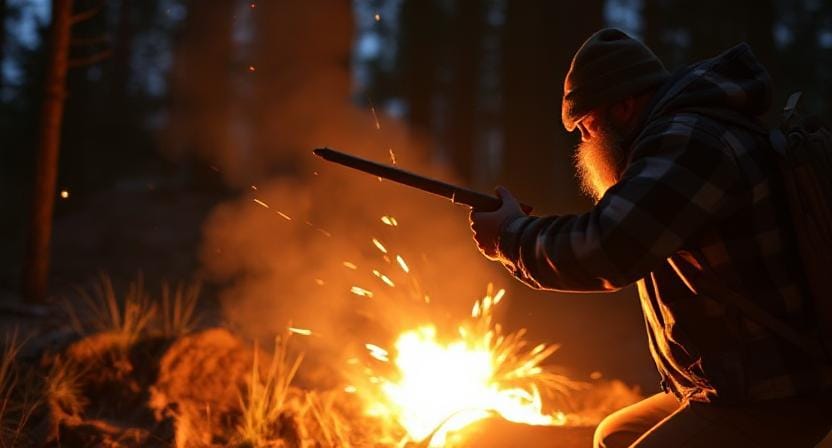
Before we jump into fortifying your space like it’s a medieval castle, let’s take a moment to understand what threats might lurk in the shadows. In the wild, danger can come from various sources—wild animals, other people (yikes!), or even natural elements like floods or falling trees.
First off, wild animals are often more scared of you than you are of them. However, it doesn’t hurt to be cautious! Familiarize yourself with local wildlife; know which creatures might pose a threat.
Imagine you’re out in the wild, feeling excited and a bit adventurous. Bears and mountain lions? Yeah, they’re amazing but also need to be respected. If you spot tracks or droppings, it’s like a big flashing sign saying, “Hey, maybe move along.” Trust me, you don’t want to surprise a bear.
Then there are other people. You might run into fellow adventurers, which is awesome. Connecting with others can be super fun! But some folks aren’t always there for good reasons. If something feels a bit strange, listen to your gut. Your instincts can be your best friend out there.
Keeping an eye on your surroundings is key. Take a moment to breathe and look around. Is everything feeling safe? Or does something seem a little… off? Just being aware can save you a lot of stress later.
And we can’t forget about the weather! A sudden storm can pop up and totally change everything. Imagine snuggly in your shelter, then—bam! Rain, wind, and chaos. Knowing the weather patterns in your area helps a ton. Keep an eye on the sky. If clouds look angry, it might be a good time to secure your stuff and get ready.
You’ve worked hard to create your safe little corner of nature. Staying alert about everything around you lets you enjoy it more. When you feel secure, it’s easier to soak up all the beauty. Enjoy the adventure, but always be smart about it!
Creating Physical Barriers

Now that we’ve found possible hazards, let’s speak about how to protect ourselves, starting with physical obstacles! You should think of these as the first line of defense for your base of operations.
One good way to do this is to use things like branches and logs to make fences or walls. A simple barrier can keep curious animals away and give you piece of mind. If you’re feeling very ambitious (or maybe just bored), you could make a palisade, which is a wall made of sharpened stakes that are pushed into the ground.
Oh, and make sure your shelter is safe before the sun goes set. Check that all the doors and flaps are tight. You really wouldn’t want someone to show up at 3 AM, would you? That’s the last thing you want while you’re trying to get some sleep. Oh no!
Also, think about where you set up. Take advantage of nature. If there is a cliff or some thick shrubs nearby, they can assist keep your area safer. It’s like putting on another layer of protection. Animals and maybe even some people might stay away.
Just think about it. Everything outside stays where it belongs, and you’re secure and sound in your small refuge. You’ll feel better and ready to face the day when you get up in the morning.
Believe me, these small pieces of advice can make a big difference. Don’t worry about the beauty surrounding you. You’ve put in a lot of effort to make your space. Let’s keep it that way!
Setting Up Warning Systems
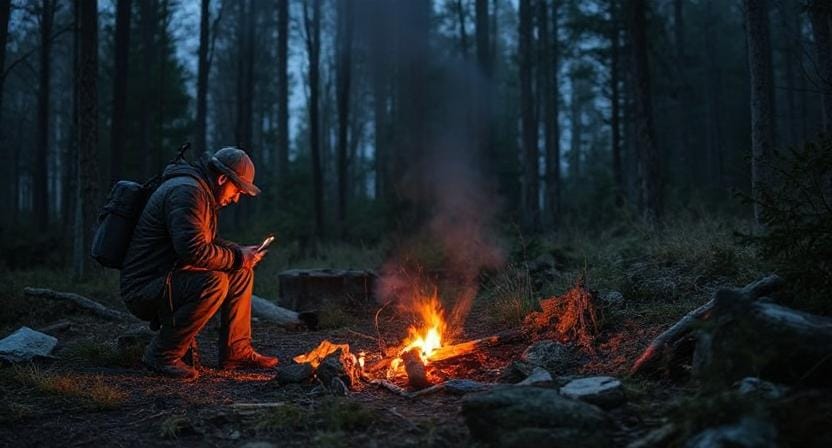
Okay, so you have barriers up. But how do you know when someone or anything is getting close? Enter warning systems! These smart systems work like alarm bells to warn off would-be attackers.
Making noise traps out of twigs or cans tied together along paths that lead to your base is a simple but efficient technique to do this. If someone or something steps on them, they’ll generate enough noise to wake up even the deepest sleeper.
You can also be creative with safety! You could hang sparkling aluminum foil from branches. In the wind, it flutters, and in the sun, it sparkles. You will see it immediately away if something moves close by. It’s a basic trick that works very well.
Think about getting motion sensors if you like electronics and have some equipment lying around. They’re really neat. They’ll tell you if anything is moving around your camp. Just be ready because batteries can die out there. When the warnings stop, you don’t want to be caught off guard.
Imagine how safe you’d feel if you knew you’d see or hear any activity before it got too close. It makes your brief trip feel even more comfortable. You may appreciate nature without having to worry. It’s good to have that peace of mind. You could even like the sound of the wind blowing through the foil. Nature’s lullaby, right?
Practicing Situational Awareness
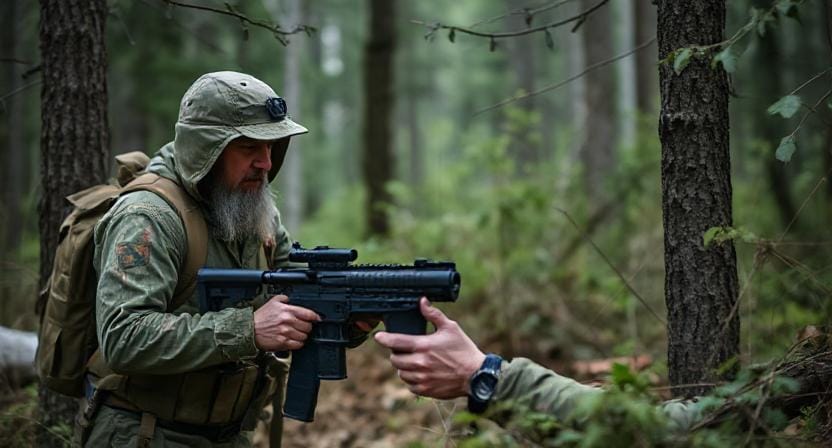
We’ve strengthened our perimeter and set up warning systems. Now let’s talk about one important skill: situational awareness! It’s not just about being aware of danger; it’s about developing an instinctual sense of what’s going on around us.
Every day, check both your immediate surroundings and the bigger picture for changes. For example, changes in animal behavior could mean that there are risks around, and strange sounds could mean that disaster is coming.
It’s a real treat to take some time to just relax and watch nature. You notice so many small things. Like how birds fly up high and swoop down. Or how squirrels are always busy running about. You may see a complete planet there in front of you. It feels calm, doesn’t it?
It’s also helpful to know what’s going on around you. Being vigilant is good, but not too jumpy. You don’t want to be nervous and look at every shadow. That can make you go crazy. You know, there’s a balance. Enjoy the moment, but stay alert.
Life loves to surprise us. You might locate a cool rock or even a stream that isn’t seen. Or, you might see something you weren’t expecting. Who knows? Those tiny surprises might make your trip a lot more fun. Being aware of your surroundings can make a quiet day at camp remarkable. You’ll feel more connected to the wild around you. It also provides you an opportunity to relax and rejuvenate. Some time in nature!
Building Community Connections
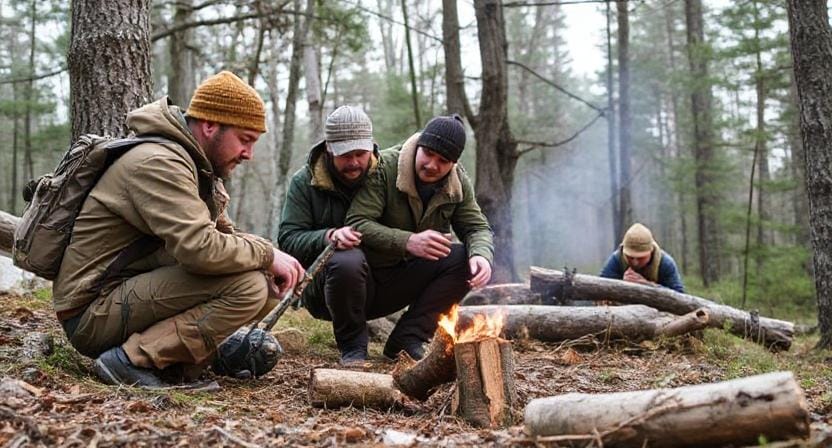
Finally, and maybe most significantly, don’t forget how crucial community relationships are! At first, being alone might seem like a good idea, but having friends can help you stay safe in a lot of ways.
If you don’t already go on group outings with other people in outdoor communities, you should start doing that before you go on solo travels.
The best thing is to find wonderful people to camp with. You can operate together. When you have friends nearby, it’s much easier to keep your place safe. Think about putting up your camp together, exchanging refreshments, and keeping a look out for bears or other animals. That way, it’s not as scary!
It’s also quite helpful to get to know people in the area. They have a lot of anecdotes and advice on the place. You can tell stories over a hot drink. They’ll tell you where to find a secret brook or the best locations to climb. When you’re out exploring, those little mysteries can make a tremendous difference.
And getting together over a campfire is magical. Imagine the stars glittering above while everyone laughs and tells stories. It feels warm and safe. Those times bring people together. You feel more connected to the outdoors and to each other.
When you have someone around you, it’s much easier to deal with problems. There may be some hard times, but having friends around you helps them seem less scary. You’re a team, ready to take on whatever comes next. Also, making those connections gives you memories that will last a lifetime, like warm hugs on cold nights. That’s what it’s all about.
A secure survival base starts with awareness, preparation, and smart defensive planning. Simple tools like barriers, noise traps, and terrain advantage can greatly increase safety. By staying alert, watching for threats, and building trusted alliances with others nearby, anyone can protect their camp and maintain peace of mind in the wilderness.
Frequently Asked Questions
How can I secure my survival base quickly?
You can secure your base quickly by creating simple barriers with logs, rocks, or branches to discourage animals and intruders while defining a clear perimeter.
What is a natural alarm system in the wilderness?
A natural alarm system uses sticks, stones, or noise traps placed along entry paths to alert you when something approaches your camp.
Why is a fire useful for survival security?
A small fire provides light, warmth, cooking ability, and acts as a deterrent to most wild animals that avoid flames and smoke.
How do I stay aware of nearby threats?
Practice situational awareness by scanning your surroundings, listening for unusual sounds, and watching wildlife behavior that may signal danger.
What threats should I prepare for outdoors?
You should prepare for threats such as wild animals, unfamiliar people, harsh weather, and falling trees or debris.
How can terrain improve camp security?
Setting camp near natural barriers like cliffs, dense brush, or elevated ground increases defense and limits access points.
Why is building community important in survival situations?
Trusted connections with nearby people offer shared defense, faster problem-solving, and emotional support during emergencies.
Suggested Resources:
Survival Skills Guide
https://www.survivalskills.com
Wilderness Survival Techniques
https://www.wilderness-survival.net
How to Build a Shelter
https://www.outdoorlife.com/shelter-building-guide

Kevin Collier is a seasoned outdoor enthusiast and writer for Trekbug.com, specializing in outdoor adventures, survival strategies, and prepping insights. With a deep love for nature and a commitment to self-sufficiency, Kevin empowers readers to embrace the wilderness confidently. He shares valuable tips, practical techniques, and inspiring stories, helping both novice and experienced adventurers develop essential skills for surviving and thriving in the great outdoors.




